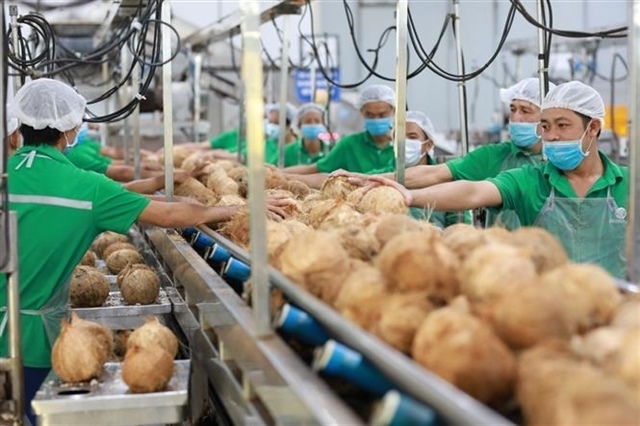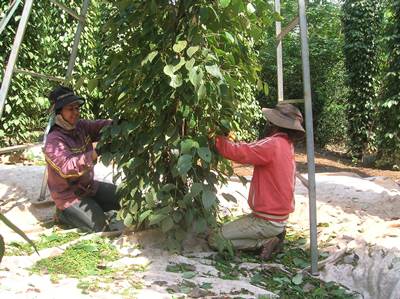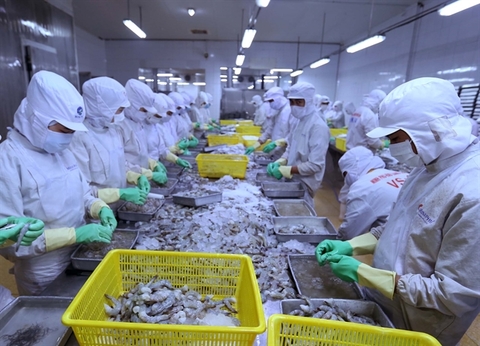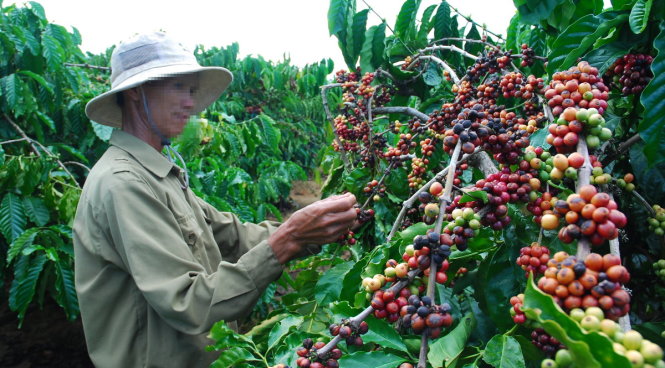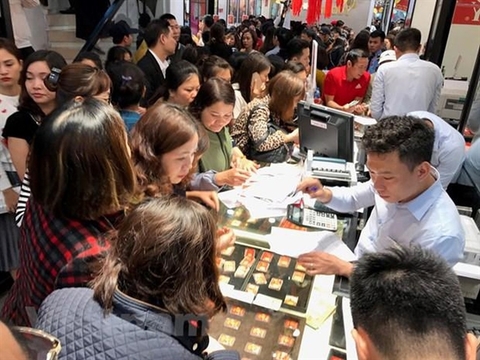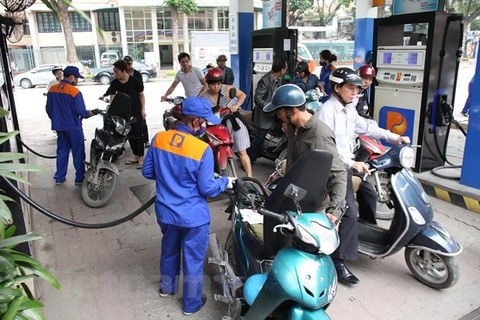Meat trade heats up through EVFTA
Meat trade heats up through EVFTA
With the EU-Vietnam Free Trade Agreement expected to take effect later this year, Vietnam is bracing itself for an onslaught of fresh meat and processed food products from the EU, sharpening competition with local goods. However, the deal will also open the doors for larger Vietnamese seafood exports to the EU.
The EU-Vietnam Free Trade Agreement (EVFTA), which has just been signed, is expected to open up two-way trade opportunities for Vietnamese and EU products. The EU has committed to remove tariffs on live animals, buffalo meat, beef, and pork imported from Vietnam right after the agreement comes into effect, as well as gradually remove tariffs in five or seven years for poultry and foods processed from beef and pork.
According to the EVFTA, Vietnam will also remove import tariffs of many EU foodstuff product lines. For example, frozen pork meat will be duty free after seven years, beef after three years, dairy products after a maximum of five years and food preparations after a maximum of seven years. Tariffs on chicken will be progressively reduced to 0 per cent in the next 10 years.
The outlook on the EVFTA is a mixed basket at best. For the consumer side, better access to a larger variety of goods that are of higher quality and safer, at a relatively good price to boot, will certainly be a boon. However, this good pricing of EU imports is the very pain point producers and farmers are concerned about as it will eat into their competitiveness on their home market.
Growing competition
As a long-term entrepreneur in the farming industry, Pham Duc Binh, chairman of Thanh Binh Corporation, stated that the EU’s farming industry is developed, featuring large-scale farms and high-quality products. For example, the price of frozen pork exported to Vietnam from EU countries can fetch VND30,000 ($1.30) per kilogramme. Currently, the tariffs on meat imported from the EU are rather high at 10-40 per cent. If they are removed, meat imports from the EU will significantly increase.
“While the tariff reduction will improve the pricing point of these products, customers are also interested in safe and hygienic food products, which all points to increasing competition. Cheaper EU imports of higher quality and traceable origin which are also compliant with Global GAP practices may very well knock out local meat,” Binh explained his concerns.
Nguyen Kim Doan, vice chairman of the Dong Nai Animal Husbandry Association, said that the cost of farming is rather high, reaching 60-70 per cent of the selling price. “If operations are not scaled up and costs do not reduce, it will be hard for the meat of local producers to compete with foreign ones,” he said.
However, the tariffs are scheduled to be removed within three-seven years for meat imported from the EU. Doan said that the time is enough for the local farming industry to improve competitiveness, including importing modern and cutting-edge machinery.
A recent report of Bao Viet Securities also pointed out that Vietnam has been importing a number of milk products from the EU, such as whey, butter, cheese, milk powder, and powder cream. As the EVFTA takes effect, these imported products will be heavy-weight competitors for local ones thanks to their advantages in quality and nutritional value.
In fact, the agreement brings huge benefits and numerous challenges for Vietnamese businesses. Of these, the biggest difficulty is meeting all requirements and standards of EU consumers.
Tran Tuan Anh, Minister of Industry and Trade, emphasised that: “Although tariffs are going to be removed, other barriers will remain. These include the EU’s standards regarding food safety and hygiene, animal and plant quarantine regulations, as well as sustainable development targets. Moreover, Vietnamese products must meet the conditions on employment and working conditions at the business. These are the main challenges for us.”
According to some economic and trade experts, the EU has quite strict standards for importers. “For example, local products should have environmentally-friendly packaging and there is a very low antibiotic residue level allowed in shrimp. Besides, we could provide some additional voluntary criteria,” said Le Ky Anh, a trade expert from the EU Delegation to Vietnam.
Opportunity for Vietnamese seafood exports
While meat products may face fierce competition by imports, EU members are also opening their doors for Vietnamese seafood products under the EVFTA.
The EU has been the second-largest seafood export market of Vietnam, after the United States. This market consistently accounts for over 17-18 per cent of the total seafood export turnover of Vietnam every year. In particular, in shrimp products, the EU accounted for 22 per cent of Vietnam’s export turnover, while pangasius accounted for 11 per cent and other seafood products for 30-35 per cent.
As soon as the EVFTA comes into effect, nearly half of the 840 tariff lines for seafood products are subject to the basic tax rate of 0-22 per cent, of which the majority of high taxes from 6-22 per cent will be reduced to zero. About 50 per cent of the remaining tariff lines with a base tax rate of 5.5-26 per cent will be reduced to zero within three to seven years. Particularly, the annual import tariff quota for canned tuna and fish is 11,500 tonnes for the EU, and 500 tonnes for Vietnam, respectively.
Frozen tiger shrimp is entitled to immediate tax reduction from the base rate of 20 per cent as soon as the agreement comes into effect. Other shrimp products will follow a three-five year schedule, while processed shrimp will follow a seven-year tax reduction schedule. Reductions for pangasius products will follow a roadmap of three years, while it is seven years for smoked fish.
Frozen tuna products get a tax reduction to zero right away, except for frozen tuna loin that needs a seven-year roadmap, and canned tuna products with a zero tax rate.
In addition to tariff reductions, the Vietnam Association of Seafood Exporters and Producers (VASEP) said that the new-generation FTAs, particularly the EVFTA, will offer unparalleled opportunities to expand export markets for Vietnamese seafood, increasing competitiveness compared to rivals without the EVFTA.
For example, in the tuna sector alone, Thailand and China are Vietnam’s two largest competitors, but neither of them have signed FTAs with Europe, which means Vietnam will hold an absolute tariff advantage over its rivals in European markets.
Furthermore, according to the VASEP, Vietnam will become more attractive for foreign investors, enhancing capital inflows and technology transfer to improve production technology and product quality. Especially, Vietnam will have the opportunity to enter deeper into global supply chains as multinational groups switch investment locations to Vietnam. Also, the EVFTA will create a stable and transparent business environment for Vietnamese enterprises.
To take advantage of the EVFTA and avoid risks, and limit the disadvantages brought about by the new challenges, seafood processors and exporters need to understand and apply the rules of origin of the EVFTA. In addition, they should also find and develop raw materials in the country and in EU markets.
“Enterprises need to pay special attention to implementing and meeting regulations, labour and environmental standards, as well as issues related to sustainable development – all requirements under the EVFTA. Businesses need to strengthen co-operation and focus on chain links to improve productivity, quality, and control,” said a VASEP representative.






